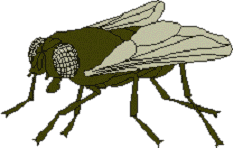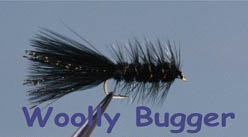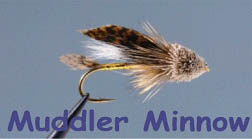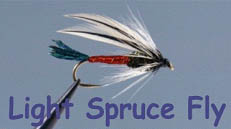Fly Fishing with Doug Macnair The Flies Part 2
Fly Fishing with Doug Macnair The Flies Part 2
By Doug Macnair
The Right Fly for the Right Time & Place.  Once armed and quipped with a selection of flies representing the categories discussed, you face the challenge that confronts every fly fisher: “Which fly do I use?” The right choice usually means success and a fish or two; the wrong choice usually means hamburgers and fries for supper. Unfortunately, there is not a quick and precise answer to the question. The fly fisher’s first choice is to present to the fish a fly that emulates the popular fare of the day. The easiest way to do this is to examine the stomach contents of a recently caught fish. There are several small stomach pump kits designed for just this purpose. If you follow the simple directions, the fish will not be harmed. Actually, it is a very simple and quick procedure. The only problem with the stomach pump is catching a fish to examine. No fish, no stomach pump. Once armed and quipped with a selection of flies representing the categories discussed, you face the challenge that confronts every fly fisher: “Which fly do I use?” The right choice usually means success and a fish or two; the wrong choice usually means hamburgers and fries for supper. Unfortunately, there is not a quick and precise answer to the question. The fly fisher’s first choice is to present to the fish a fly that emulates the popular fare of the day. The easiest way to do this is to examine the stomach contents of a recently caught fish. There are several small stomach pump kits designed for just this purpose. If you follow the simple directions, the fish will not be harmed. Actually, it is a very simple and quick procedure. The only problem with the stomach pump is catching a fish to examine. No fish, no stomach pump. Besides doing research or homework on the waters fished, the time of year and the habits of the particular fish, your other alternatives begin to narrow. In truth, most waters have one or two experts nearby -- expert because they have spent years studying, analyzing and fishing those specific waters. Tapping their knowledge may not as hard as you might think. That’s one of the unique things about the community of fly fishers. Most are unselfish. Ask and you are most apt to receive the required information. As a last resort, there may be a local fly or bait shop nearby. In many areas of the country, however, it may be only a bait shop, only. Unfortunately, most true bait shops know much of anything about flies other than screening the porch to keep them at bay. Of course, it’s possible someone may have published a fly fisher’s aid for the waters in question similar to what Steve May is doing for fly fishers in Vermont. If someone has done a “match the hatch” for the local waters, buy it! It is most apt to save you endless hours and perhaps the fishing trip. If none of these things are available, little is left to try but the tedious process of trial and error. The Lucky Flies. A few flies seem to have universal appeal to friend fish. Call them “lucky” because they seem to work almost anywhere and on any fish most of the time. To shorten the trial and error process, these flies should be the first added to any collection. In 1996, Sports Afield took a swag at picking the 10 top flies. As Dave Carty said in his article, The Outfitter, “Picking the 10 greatest trout flies is like picking the 10 greatest moments in sport history -- not a subject immune to debate.” Admittedly, it is tough and imperfect, but here they are: Streamers.  1. The Woolly Bugger. This fly always seems to be at or near the top of the list of many prominent fly fishers. While some argue that it is not a streamer, no one seems to be able to place in a better category. For that matter, no one seems to know why it catches fish. Whatever the truth, this fly is a swimmer. To make things simple, I like to think of it as an attractor simply because it does not look like anything in my water columns. It is best, I think, in black or olive with a soft hackle tail, a bit of Flashabou (glitter), and tied weedless. 1. The Woolly Bugger. This fly always seems to be at or near the top of the list of many prominent fly fishers. While some argue that it is not a streamer, no one seems to be able to place in a better category. For that matter, no one seems to know why it catches fish. Whatever the truth, this fly is a swimmer. To make things simple, I like to think of it as an attractor simply because it does not look like anything in my water columns. It is best, I think, in black or olive with a soft hackle tail, a bit of Flashabou (glitter), and tied weedless.  2. The Muddler Minnow. This fly was acclaimed years ago as the fly destined to become fly fishing’s best all-around fly. Perhaps it is. The Muddler classifies as a hair bug streamer, with head and hackle fabricated of deer hair and body of gold tinsel, and with tail and wing of turkey quill. This may not mean anything to you now, but it will later if you get into the art of fly tying. 2. The Muddler Minnow. This fly was acclaimed years ago as the fly destined to become fly fishing’s best all-around fly. Perhaps it is. The Muddler classifies as a hair bug streamer, with head and hackle fabricated of deer hair and body of gold tinsel, and with tail and wing of turkey quill. This may not mean anything to you now, but it will later if you get into the art of fly tying.  3. The Spruce Fly. I have never fished this pattern, but it looks good. It is a brightly colored attractor that apparently works well in either the East or the West. This being true, I would be very surprised if it failed to produce in Texas waters. In its brighter colors, the fly reminds me of an old streamer fly called the Silver Doctor -- a fly expressly designed for Atlantic salmon. Although I have never fished for Atlantic salmon, I have used this pattern on Texas smallmouths with great success. I suppose they believe they are distant relatives to the mighty salmon or the rivers of Texas are part of the Atlantic. I just wish I had a source for replacements. The Doctor seems to have gone the way of too many great flies… 3. The Spruce Fly. I have never fished this pattern, but it looks good. It is a brightly colored attractor that apparently works well in either the East or the West. This being true, I would be very surprised if it failed to produce in Texas waters. In its brighter colors, the fly reminds me of an old streamer fly called the Silver Doctor -- a fly expressly designed for Atlantic salmon. Although I have never fished for Atlantic salmon, I have used this pattern on Texas smallmouths with great success. I suppose they believe they are distant relatives to the mighty salmon or the rivers of Texas are part of the Atlantic. I just wish I had a source for replacements. The Doctor seems to have gone the way of too many great flies… Nymphs. In this class of trout flies, top honors were awarded to the Hare’s Ear, Brassy, and Pheasant Tail. As Dave Carty suggests, the Hare’s Ear imitates almost every underwater insect. Never be without one or two or even more. The Brassy is so simply tied, even I can tie it -- it is little more than copper wire and black dubbing. (If the fly tying bug bites you, do this one first.) The Pheasant Tail works best when fished as an emerger, a little beyond the scope of this book. I’ve frequently fished this fly and conclude that few Texas crappie or panfish can pass it by. Dry Flies. The winners in this group include the Elk Hair Caddis, Stimulator, and the Royal Wulff. The Elk Hair Caddis is another fly I have never fished, but according to Dave Carty, it’s a winner designed by Al Troth of Montana. The Stimulator is a multi-threat fly used equally well to imitate a caddisfly, a hopper or as an all-purpose search pattern. (Be sure to carry one or two.) The Royal Wulff is credited to Lee Wulff, a famous fly fisher and fly tier. His name is one you will find several times during your review of this book. The fly is basically the revamp of a classic fly called the Royal Coachman. It floats well and with white wings can easily capture the attention of a hungry trout. The final fly in this group of 10 is an old fly called the Adams. It is so old even I have fished it, but only as a dry fly. For whatever reason, the article in Sports Afield listed the Adams under the nymphs. There is an Adams Midge, but ordinarily when talk turns to the Adams, it is the dry fly folks are referring to. The Adams does an outstanding job of imitating a “bunch” of mayflies. For a traveling fly fisher, you might say, “Don’t leave home without it!” You cannot go wrong by having this pattern in your inventory. You might wonder why these trout flies are featured in a book that is certainly not confined to trout fishing. The answer is that these same flies are most apt to work on other species besides trout. Why did the smallmouth bass tear into my Silver Doctor? Probably because the fly angered them when it wandered into their turf. But I can never be certain of this. Not one of the smallmouths I interrogated could be duped or tricked into spitting out the truth, or even the fly. To the 10 flies just discussed, do not forget to add the Black Gnat and/or the Black Ant and, finally, the Zug Bug. Why one, if not all three were omitted from the list, I will never know. Are there other flies to be considered? Sure! Lefty Kreh, famed for his expertise in these matters, always hands out accolades to the Clouser Minnow. (The deep minnow depicted here is for all practical purpose a Clouser.) He recommends a dark yellow wing on the bottom, 2 or 3 strands of Crystal Flash, and a dark brown upper wing. As an alternative he suggests dressing the clousers in all black or olive with 6 to 8 strands of Crystal Flash. He also discusses the Sculpin, a streamer fly, warning that it only works when fished properly. Designed to imitate a baitfish that’s nocturnal, the Sculpin is best fished during low light conditions or at night. Lefty’s other favorites include the Woolly Bugger (previously shown), the Muddler Minnow (previously shown), the San Juan Worm, Black Dace, and Zonker. If a couple of these sound familiar, they are. About the only fly he doesn’t mention is his own Deceiver. I probably fish the deceiver in one of several forms more than any other fly. You simply cannot be wrong by own deceivers matched in size to fish you hope to catch. If you commit to this sport, Lefty’s comments are well worth collecting. Unfortunately, a descriptive narrative without complete inventory of pictures leaves a lot to be desired, does it not? All the words in the world will not enable you to see the many flies in these categories as they really appear. And seeing these flies is very important. The old adage is true; a picture is worth a thousand words. Not to worry! Coming up next is a list of companies that cater to the needs of the fly fishers. Each publishes an annual catalog containing their featured product lines to include such things as rods, reels, lines, leaders, tippets, fly tying gear, and accessories. More importantly, these companies feature flies, all kinds of flies -- big and little flies, flies for trout and bass, flies for salmon and steelhead, flies for blue water, flies for the saltwater flats as well as blue water. Taken together these companies list more flies (along with their retail price) than I could ever picture in this book. Most of these catalogs are free, particularly if you explain you are new to the sport—simply call the number listed and make known your request. Please realize that this list is not all-inclusive; these are simply a few that I have familiarity with and whose service is never less than excellent. I can ask no more. (The following list is in alphabetical order only) - American Angling Supplies. Beautiful pictures in this one. Ask for Al or Dave when calling (603) 893-3333.
- Cabela’s. A big outfitter, Cabela’s publishes several catalogs. Be sure to ask for Fly Fishing. (800) 237-4444 to order, customer service or product specialists.
- Dan Bailey’s Fly Shop. Good photography, wide selection, a helping hand. (800) 356-4052.
- Feather-Craft. Excellent photography, newsy catalog, good help and good folks and an outstanding selection of flies. (800) 659-1707.
- Kaufmann’s Streamborn. Broad selection and excellent photography. (800) 442-4359.
- L. L. Bean. Good photography, ask for Fly Fishing catalog. (800) 221-4221 to order, (800) 341-4341 for customer service and product specialists.
- Madison River Fishing Company. More narrowly defined fly selection but good quality, Black and White photography only. (406) 682-4293.
- Orvis. Excellent photography and service. Wide selection, good photography and quality. (800) 548-9548 to order.
- Scientific Anglers. In depth, wide ranging selection, excellent photography, quality product(s).
- The Fly Shop. Excellent photography, broad selection for saltwater. (800) 669-3474 to order or for product information.
Do as I suggest, call and order several of these catalogs. Compare the flies named and pictured against those mentioned during this discussion. In but a moment or two the image of the Woolly Bugger will be etched in your mind forever; no longer will you wonder at the look of the San Juan Worm; or ponder again whether or not you can be deceived by Lefty’s Deceiver. The next thing you will discover is that flies are available in an array of sizes. For now, all you need to know are two things: first, the size of the hook governs the fly’s size; second, the size of the hook should match the size of the fish. Most flies for fresh water are sized from 1-22, where I is big and stronger and 22 small and comparably weak. For large fish, such as those in saltwater, flies are sized from 1/0 upward to say 5/0, where 1/0 is small and 5/0 is big. Most fly fishers who chase big tarpon would opt for a hook no smaller than 3/0. Generally for bonefish, permit, redfish and trout, flies are sized below I/0 -- anything from 2-8 is probably satisfactory. Before someone takes exception to the last statement, realize the larger the fly the more precise the required presentation, especially when sight casting to fish. One final word about sizing flies: historically sizes 10-22 are those associated with trout, with 12-18 being the most common. Lots of fly fishers go with the old philosopher who said, “Big flies for big fish.” Just remember this: in the world of fly fishing, nothing is absolute -- lots and lots of big fish have been caught on little flies. Then, too, never forget all that has thus far been mentioned is the fly. There is much more to consider before this thing that I call a fly fishing rig is brought together as a whole, becoming, at that point, greater than the sum of its parts. For example, fly rods and fly lines are also sized by weight, where 1 is light and 15 is heavy. The standards of the American Fly Tackle Manufacturers Association (AFTMA) apply. Suffice it to say that a 1-weight is far too light to cast a tarpon fly with a 2/0 hook. Try it -- the rod will bend, barf, and break while the Fish Gods laugh and frolic in wild unmitigated pleasure. Supposing the fly tying bug really bites you. Just suppose it does … What to do? If you want to know more about flies and fly tying, check out these books. - One of the finest series of references in this country are the works of Dick Stewart, the former owner of the American Angler Magazine. I suggest Dick Stewart’s Bass Flies, Fly typing Tips & Universal Fly Tying Guide. For shear beauty and grace in detail and photography, try any of the works by Dick Stewart and Farrow Allen: Flies for the Atlantic Salmon, Flies for Bass and Panfish, Flies for Saltwater, Flies for Steelhead and Flies for Trout. Trust me, you cannot go wrong.
- If the saltwater flies capture your fancy, be sure to add Lefty Kreh’s Saltwater Patterns, (Revised).
- It you become fascinated with fly tying and decide to try your hand, let me pass on to you what Steve May of the Wright Rod Company passed to me. He is a master tier who routinely teaches dummies like me how to tie flies. (Unfortunately, the distance between Websterville, Vermont, and Houston, Texas, is a tad more than an hour’s drive precluding me from attending one of his courses.) After looking through several books reputed to be “greatest,” I finally asked him to order and send me what he considered best. With that background, I am confident that you, too, will find delight in, Production Fly Tying by A. K. Best. The remarks on the cover say it all: “(It is) a collection of ideas, notions, hints, and variations on the techniques of fly tying.”
Note: A special word of thanks goes to Scientific Anglers for their kindness in providing the fly photography depicted in this two-part series. Photographing flies requires equipment and skills I do not have. This courtesy is in keeping with everything Scientific Anglers does to support the sport. For Your Interest, the McKenzie International Fly Guide by Scientific Anglers, listing all 725 core and designer patterns available along with informative Hatch Charts, is available from Scientific Anglers' Mastery Series dealers - or by sending $5 to: 3M Scientific Anglers - 3M Center Bldg. 223-2N-01 - St. Paul, MN 55144. Dave Carty, “The Outfitter,” Sports Afield, April 1996, Page 125.
Bernard “Lefty” Kreh, Fly Fishing for Trout, Odysseus Editions, Inc., Birmingham, Alabama, 1992, Page 158-168.
|
